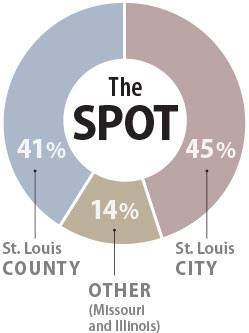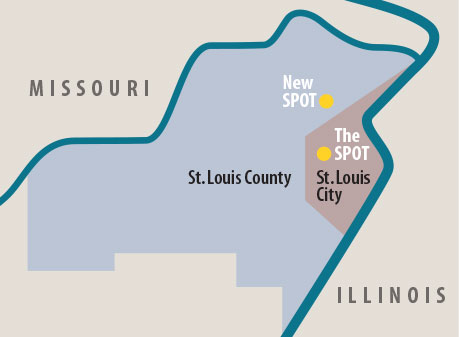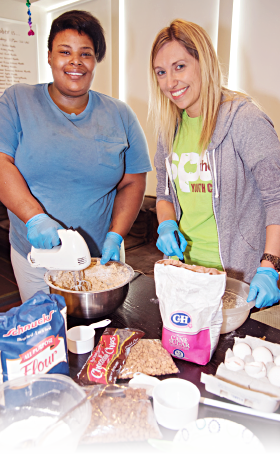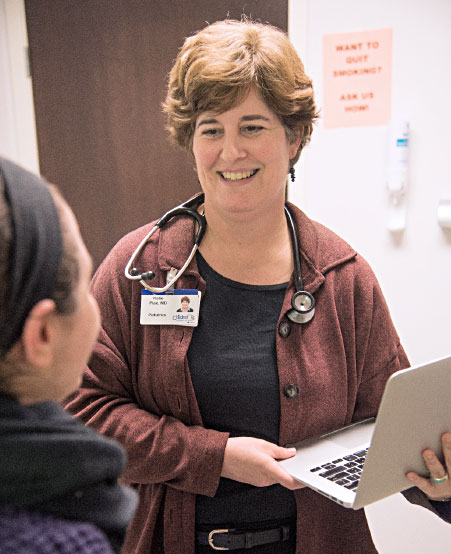
On The SPOT care
Youth clinic heads to school in north St. Louis County
By Hilary Davidson
Learn More
Project ARK/The SPOT recognized as model program by federal/state agencies
A one-stop, drop-in clinic offering free confidential medical care, mental health counseling, testing for sexually transmitted diseases (STDs) and HIV, and other services to youth aged 13 to 24: That’s the mission of The SPOT (Supporting Positive Opportunities for Teens). Located in St. Louis City, this Washington University clinic has had a huge impact, treating more than 10,000 since opening in 2008.
The SPOT Medical Director Katie Plax, MD, director of adolescent medicine and professor of pediatrics, noticed that many SPOT patients came from the north St. Louis County municipalities of Ferguson, Florissant and Jennings.
“The majority of St. Louis County youth we see are from north St. Louis County,” said Plax. “We wanted to figure out something that would be convenient and closer to them.”
At the same time, Jennings Senior High School Principal Dayle Burgdorf was looking for ways to keep kids at school. Burgdorf learned that the long treks some students must make to take care of chronic health conditions are a major cause of absenteeism. She then met with Sarah Garwood, MD, an assistant professor of pediatrics and physician at The SPOT.
Far-reaching impact
The current clinic in St. Louis City sees a nearly equal number of patients from the city and county, plus others across the metro area.

“The idea of bringing the clinic to the kids is very appealing to us,” Burgdorf said.
The Jennings School District is modifying a room to house the clinic, and funding from the St. Louis County Children’s Services Fund supports this collaborative effort. The new school-based program will offer mental health counseling, case management and wellness education. The team hopes to provide medical services in the near future, but at this time funding to provide medical care has not yet been achieved.
“This is an opportunity to make health-care services accessible for students and families,” said Anthony Robinson, EDD, director of secondary education at Jennings Senior High School. “It helps build healthy communities and, in turn, helps students with academic performance.”
While only Jennings High School students will be able to use the clinic, Garwood, Plax and The SPOT Program Director Kim Donica, LCSW, view this as a starting point to open similar clinics in other north St. Louis County schools.
The city-based SPOT
When The SPOT opened its doors at its first location (4169 Laclede Ave.), organizers expected to serve 500 youth in the first year. Instead, clinicians served that many in three months. In 2009, The SPOT’s first full year of operation, 1,879 new patients sought assistance.
“The numbers have steadily increased each year,” Donica said. “We served more than 3,100 clients in 2014.”

The new location at Jennings Senior High School will broaden The SPOT’s reach into north St. Louis County.
SPOT medical staff members are affiliated with Washington University, and the clinic also partners with community-based organizations to provide many services under one roof. For example, The National Council on Alcohol and Drug Abuse supplies a full-time substance abuse counselor at The SPOT.
The clinic offers shower and laundry facilities and a recreational space where youth can watch TV, surf the Internet, grab a snack or participate in counselor-led activities.
Plax said the “safe drop-in space” is key to The SPOT’s success. “Youth can come check us out, see what the place is like, and engage in any of the other services we offer,” she said. “Meeting The SPOT staff helps them overcome the stigma of seeking help.”

Delivering when it counts
Although there are many reasons for The SPOT’s success, one thing is certain: Young adults need support to become successful adults. “This is a critical juncture to learn the skills to be a healthy and functional adult,” Plax said. “Times are hard, youth unemployment is high, and people need help and support to launch.”
Plax and Donica see many opportunities to help more youth. One priority is to attain funding for basic medical care for older youth. The SPOT is temporarily funded by grants, some of which are not renewable. Many patients are 20 to 24 years old — too old to qualify for state and local government funding.
“Federal grants by and large don’t cover medical care because there is the belief that it is going to be covered by Medicaid expansion,” Donica explained. Missouri opted out of Medicaid expansion and, as a result, many youth are in a coverage gap and lack health insurance.
Additionally, The SPOT needs increased nursing and medical support. One full-time nurse sees more than 25 patients per afternoon, along with an adolescent medicine physician. A psychiatrist and a gynecologist come once a week, not often enough to meet the demand.
Cramped facilities also present problems. The SPOT is housed in 2,500 square feet, with just two exam rooms. “We’re at capacity here,” Plax said. “We just can’t fit any more people in this space.”
Despite some of the limitations, youth see The SPOT as a sanctuary. “I probably wouldn’t be alive if it weren’t for the people here,” said Alexis, 22.
After leaving her family home in anger, Alexis caught a ride with a friend to St. Louis. She learned about The SPOT while at a homeless shelter for teens.
SPOT staff helped her find housing, job training and employment during the three years she lived in St. Louis. Alexis now has two jobs, one as a pharmacy technician and one as a customer service representative — and she is enrolled in college.
Alexis credits The SPOT staff for helping to reunite her with family members. She moved back home six months ago.
While the school clinic will have a slightly different focus, both clinics will operate from the same set of core principles: creating community partnerships, involving the medical science community to optimize care, and taking action to improve health-care delivery for kids.
But the SPOT’s mission goes beyond medicine. “I don’t think medical people speak about it enough but really this is about love,” Plax said.
“You do this work because it comes from your heart. And you do this kind of engagement because you have a deep appreciation for that person sitting before you.”

LEFT: The smell of fresh-baked cookies, fun games to play and creative projects make the current SPOT an inviting place, one that goes above and beyond in its sensitive health-care mission.
RIGHT: Medical Director Katie Plax, MD, counsels a teen at The SPOT clinic.
Learn how you can partner in this important endeavor:
314-935-9691







